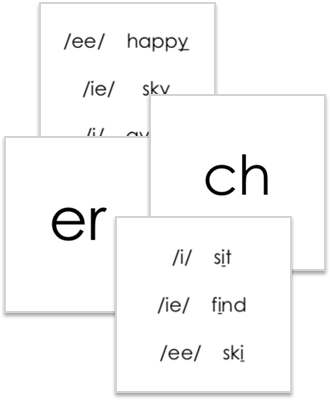Teaching the Phonograms
OnTrack Reading Phonics Program
Teach your student the phonics advanced code in as little as 8 weeks with our 170-page workbook and instruction manual.
Once you've made the changes to the rules in The Writing Road to Reading (WRTR), you can begin teaching the phonograms. Follow the instructions in WRTR, but make the modifications below:
Obtain the 84 Phonogram Cards
You will need the 84 Phonogram Cards that incorporate the changes that have been discussed. They are currently available as a PDF download of 14 front pages and 14 back pages with six cards per page. Once downloaded, you can print them on card stock and cut them apart on the cut lines.
Download the OnTrack Reading Phonogram Flashcards

Teach the first 50 of the 84 revised phonograms.
The 5th edition of WRTR instructs you to teach 45 phonograms before starting dictation of words of the Ayres List, whereas the 4th edition specifies 54 phonograms. Using the OnTrack Reading phonograms, if you teach the first 50 you will be able to then dictate all of the words in sections A-G of the Ayres list in either the 4th or 5th edition. (The lists in each edition differ because the 5th edition has had several words added to the Ayres List.) As you reach the end of sections A-G, start teaching the rest of the 84 phonograms.
Introduce the Language "Digraph," "Marker," and "Ending"
As you teach the first 50 phonograms you will also introduce the concept of a marker phonogram and an ending phonogram. Marker phonograms and ending phonograms are defined here. You will also introduce the concept of a digraph, which is just a phonogram spelled with two letters.
Phonogram #24 is the letter "x." When you introduce it, say "This is the phonogram /k/s/; it is one of four phonograms that are markers. I will explain what a marker is when we start learning to spell words." Later, refer to it as the "marker /k/s/" to reinforce its role as a marker of the first vowel sound preceding it.
Phonogram #27 is the digraph "sh." When you introduce it, say "This is the phonogram /sh/. It is one sound (demonstrate /sh/) but we use two letters to spell it. When a phonogram has two letters, we call it a digraph." Later, when you refer to it, you don't need to call it a digraph. Just refer to it as the "phonogram /sh/"
Phonogram #41 is the digraph "ay." When you introduce it, say, "This phonogram is /ae/. It is an ending digraph, so we usually see it at the end of words." Later, refer to it as the "ending digraph for /ae/" to distinguish it from other /ae/ spellings such as phonograms ai and eigh.
Repeat that same process with phonograms #43 (oy), #48 (le), #49 (ve), and #50 (me)
Later, when you teach the remaining 34 phonograms, each of the phonogram cards that introduce either a marker or an ending have notes on the cards to remind you to refer to them in that manner. Start teaching the remaining phonograms after dictating sections A-G of the Ayres List in either the 4th or 5th edition of WRTR. After teaching the first 50 of the 84 revised phonograms you can start Dictating the Ayres List.